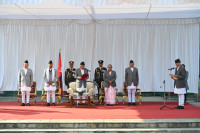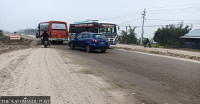National
Electricity utility worried over power spillage during festive season when demand drops
Nepal Electricity Authority is seeking India’s approval to export more energy to the power-hungry country.
Prithvi Man Shrestha
Nepal Electricity Authority said it has been witnessing power spillage and this will further rise during the festival season as the state-owned power utility awaits an Indian approval to export more electricity to India.
With hydropower projects operating in full capacity owing to continued monsoon rains, Nepal is currently producing more electricity than the existing domestic demand and the amount it is allowed to export.
The installed capacity of hydropower projects in the country is around 2200MW, while peak demand is around 1700MW, according to the NEA.
“For over a week now, about 50MW of electricity has been going to waste during the night time when the demand for power decreases,” said Kul Man Ghising, managing director of the NEA.
“And starting October, around 200MW could go to waste if we don’t get approval from Indian authorities to sell more power in the Indian market.”
He said the demand for electricity comes down during the festival season because of the closure of factories and businesses, the major consumers of electricity.
The NEA is now pondering how to use the surplus energy to make extra income.
The southern neighbour now allows Nepal to sell a maximum of 364MW of electricity in its market through the India Energy Exchange Limited, an electricity trading platform.
The NEA has been selling 37.7MW from Trishuli and Devighat hydropower projects, 140MW from the Kaligandaki, 68MW from Middle Marsyangdi, 67MW from Marsyangdi and 51MW from Likhu-4, which was developed by the private sector, according to the NEA.
The NEA earned as much as Rs7.19 billion by exporting electricity to India in the last four months—between early June and mid-September, according to the power utility.
But the NEA sought approval from Indian authorities to sell an additional 212.7MW of electricity across the border through competitive bidding in the last one-and-a-half months.
Even though the NEA had long been requesting the Indian authorities for approval to sell the power generated by the 456MW Upper Tamakoshi Hydropower Project, Indian officials refused to give their nod citing the involvement of Chinese contractors in the project, which is currently Nepal’s largest.
India instead asked the NEA to propose other projects without Chinese components to sell electricity in the Indian market.
In mid-August, the NEA had requested approval from India to sell 111.8MW generated from Mistrikhola, Likhukhola-A, Solukhola and Chilime hydropower projects.
The NEA said that it has also sought approval to sell an additional 100.9MW generated from Likhukhola, Kabeli B1, Maikhola, Hewa Khola A and Lower Modi hydropower projects.
“We expect to get approval from the Indian authorities for exporting more power,” the NEA said in a statement on Tuesday.
In the last fiscal year, 735 MW of electricity, including from solar plants, was added to the national grid.
With the addition, the installed capacity of electricity increased to 2,189.6MW in 2021-22, which consists of 2,075.4MW of hydroelectricity, 54.8MW of solar power, 6.0MW of cogeneration and 53.4MW generated from thermal plants.




 16.12°C Kathmandu
16.12°C Kathmandu















